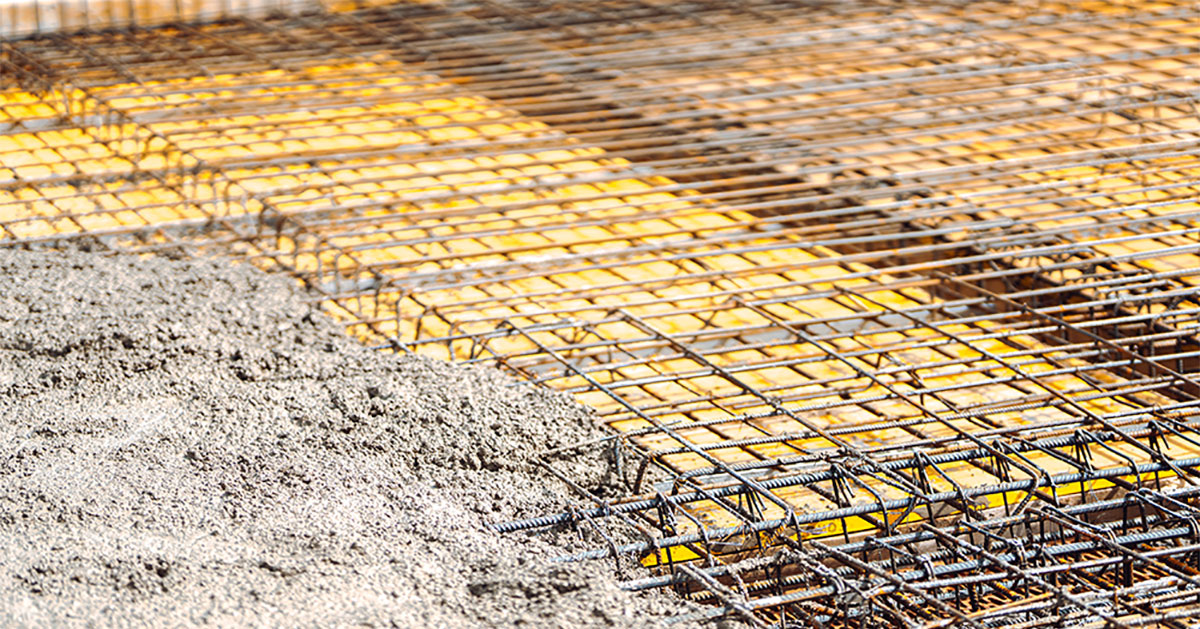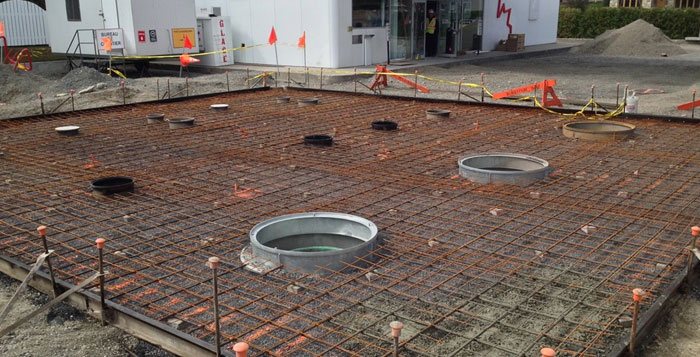
Wire mesh sheets are a type of woven wire fabric that consists of intersecting wires woven together to form a grid pattern. They are widely used in construction and other industries for various applications.
What is mesh in construction?
In construction, “mesh” refers to a material made of interconnected wires or fibers arranged in a grid-like pattern. It is commonly used in various construction applications to provide reinforcement, support, or containment. It is typically made from materials such as steel, fiberglass, or synthetic polymers. These versatile sheets provide strength, stability, and durability, making them suitable for fencing, reinforcement, safety barriers, animal enclosures, erosion control, and screening purposes. Available in different sizes and wire gauges, wire mesh sheets offer a flexible and customizable solution for diverse project needs. Their widespread use and practicality make them an essential component in many construction projects.
Read more: Geosynthetics usage In Bridge Construction
The uses of wire mesh sheets in construction
Here are a few common uses of wire mesh in construction:
- Reinforcement: Mesh is frequently used as reinforcement in concrete structures such as walls, slabs, and foundations. It helps to distribute and resist tensile forces, preventing cracks and improving the structural integrity of the concrete.
- Masonry Support: It can be used as a support system for masonry walls or structures. It provides stability and prevents the displacement of bricks or stones, particularly in areas prone to seismic activity or high wind loads.
- Safety and Fall Protection: Mesh is employed as safety barriers or fall protection systems on construction sites or elevated platforms. It serves as a protective barrier to prevent workers from falling and provides a secure working environment.
- Security Fencing: It is used for constructing fences and enclosures around construction sites or properties. It provides a physical barrier, offers visibility, and can deter unauthorized access.
- Erosion Control: Mesh materials, such as erosion control blankets or geosynthetic mesh, are used to control soil erosion on slopes, embankments, or construction sites. They stabilize the soil and prevent the loss of topsoil due to water runoff.
- Ventilation and Airflow Control: Mesh screens or panels are utilized in construction applications to allow for ventilation while preventing the entry of pests, debris, or unauthorized access. They are commonly used in areas such as ventilation systems, mechanical equipment enclosures, or window screens.
The benefits of using wire mesh in construction
Using wire mesh in construction offers several benefits that contribute to the strength, durability, and overall quality of structures. Here are some key advantages of using wire mesh:
- Reinforcement: Wire mesh serves as a reinforcing element in concrete structures, providing tensile strength and preventing cracking. It helps to distribute loads more evenly, enhancing the structural integrity of walls, slabs, and foundations.
- Crack Control: By acting as a barrier, wire mesh helps control and limit the propagation of cracks in concrete. It restricts crack width and prevents them from expanding, improving the longevity and appearance of the structure.
- Increased Load Capacity: The addition of wire mesh in concrete significantly increases its load-carrying capacity. It allows for the construction of stronger and more resilient structures that can withstand heavy loads and external forces.
- Cost-Effective Solution: Using wire mesh as reinforcement is often a cost-effective alternative to other reinforcement methods, such as rebar. It reduces labor and material costs while still providing adequate structural strength and performance.
- Easy Installation: Wire mesh is relatively easy to handle, cut, and install, making it a convenient option for construction projects. It can be quickly placed within concrete forms, saving time during the construction process.
- Crack Resistance: Wire mesh helps prevent the formation and propagation of shrinkage cracks caused by drying or temperature changes in concrete. By minimizing cracks, it reduces the potential for water penetration, corrosion of embedded materials, and degradation of the structure over time.
- Versatility: Wire mesh is available in various configurations, sizes, and materials, allowing for customization based on specific project requirements. It can be used in different construction applications, including walls, slabs, columns, and precast elements.
- Enhanced Safety: The use of wire mesh as fall protection or safety barriers on construction sites improves worker safety by preventing falls from elevated areas. It provides a secure working environment and complies with safety regulations.
- Fire Resistance: Certain types of wire mesh, such as those made from stainless steel, offer fire-resistant properties. They can help contain and control the spread of fire, enhancing the fire safety of structures.
- Erosion Control: Wire mesh, in the form of erosion control blankets or gabions, helps stabilize soil and prevent erosion on slopes, embankments, and riverbanks. It protects the environment, maintains soil integrity, and prevents sediment runoff.
Read more: Geosynthetics In Railway Construction
Mesh in construction: Different types
There are various types of mesh used in construction, each with its own specific characteristics and applications. Here are some common types of mesh used in construction:
- Welded Wire Mesh: Welded wire mesh is manufactured by welding intersecting wires together at their points of contact. It forms a grid pattern with consistent spacing between the wires. Welded wire mesh is commonly used for reinforcement in concrete structures, including walls, slabs, and precast elements. It provides excellent strength and stability.
- Expanded Metal Mesh: Expanded metal mesh is made by cutting and stretching a sheet of metal to create a pattern of diamond-shaped openings. This type of mesh offers high rigidity and strength while allowing for good airflow and visibility. It is used in applications such as fencing, security screens, walkways, and platforms.
- Woven Wire Mesh: Woven wire mesh is created by interweaving individual wires to form a grid pattern. It comes in various mesh sizes and wire diameters, allowing for different levels of strength and flexibility. Woven wire mesh finds applications in screening, filtration, partitions, and architectural elements.
- Fiberglass Mesh: Fiberglass mesh consists of woven or non-woven strands of fiberglass. It is lightweight, durable, and resistant to corrosion, making it suitable for applications requiring high strength and resistance to chemicals and weathering. Fiberglass mesh is commonly used in wall reinforcement, stucco applications, and waterproofing systems.
- Stainless Steel Mesh: Stainless steel mesh is highly corrosion-resistant and offers excellent strength and durability. It is available in various weaves, such as plain weave, twill weave, or Dutch weave, to suit different applications. Stainless steel mesh is used in architectural facades, balustrades, sieves, filters, and industrial applications requiring high corrosion resistance.
- Geosynthetic Mesh: Geosynthetic mesh refers to mesh materials made from synthetic polymers, such as polypropylene or polyester. It is used primarily in geotechnical and civil engineering applications. Geosynthetic mesh is employed for soil stabilization, erosion control, retaining walls, drainage systems, and reinforcement in road construction and slope protection.
Read more: Geogrid mesh price
What are the rabitz meshes?
Rabitz mesh, also known as wire mesh or netting, is a type of woven wire fabric typically made from galvanized or stainless steel wires. It consists of intersecting wires that are woven together to form a grid pattern. The wires are usually crimped or twisted at the intersections to provide stability and strength.
Rabitz meshes have various applications in construction and other industries, including:
- Fencing: Rabitz mesh is commonly used as fencing material, providing a secure and durable barrier for residential, commercial, and industrial properties. It can be installed as boundary fencing, security fencing, or animal enclosures.
- Plastering and Rendering: It is utilized as a reinforcement layer in plastering or rendering applications. It is attached to walls or ceilings before applying the plaster or render, providing added strength and reducing the risk of cracking.
- Safety and Protection: Rabitz mesh is employed for safety purposes, such as fall protection on construction sites or as guardrails on elevated platforms. It helps prevent accidental falls and provides a protective barrier.
- Animal Enclosures: Due to its durability, it is often used for animal enclosures, including aviaries, cages, and pet runs. It provides a secure enclosure while allowing visibility and ventilation.
- Erosion Control: Rabitz mesh can be used in erosion control applications, such as slope stabilization or retaining walls. It helps to prevent soil erosion and maintain the stability of embankments or slopes.
- Screening and Sieving: It is used for screening or sieving applications, such as separating particles or materials of different sizes. It finds use in industries like mining, agriculture, and food processing.
The list of geosynthetic products
Conclusion
In conclusion, wire mesh sheets offer a versatile and effective solution for various applications in construction and other industries. With their woven wire fabric construction, these sheets provide strength, stability, and durability. Wire mesh sheets are commonly used for fencing, plastering reinforcement, safety barriers, animal enclosures, erosion control, and screening purposes.
Available in different mesh sizes and wire gauges, wire mesh sheets can be tailored to specific project requirements. They serve as a reliable and cost-effective option, contributing to the overall quality and performance of structures and applications where they are applied.





